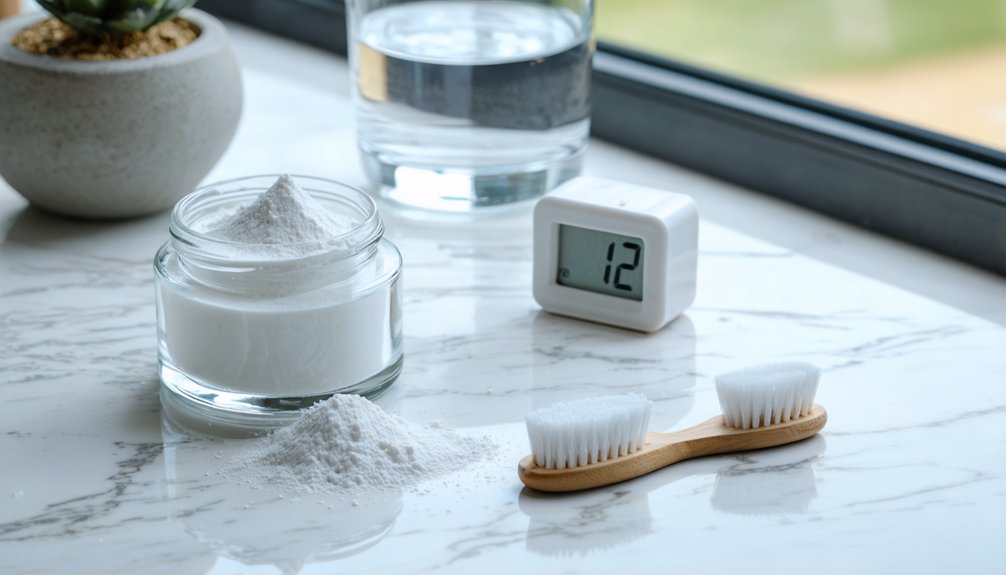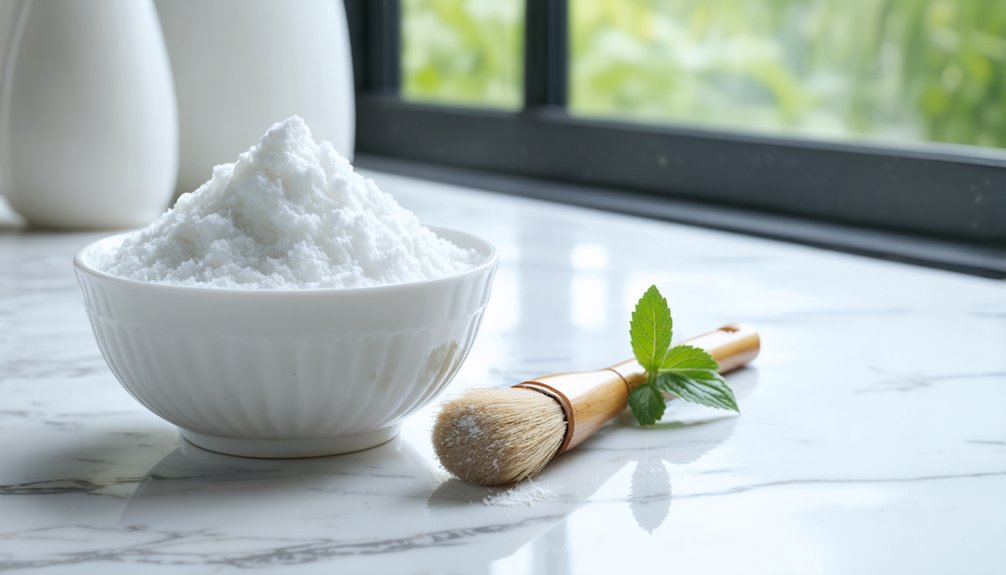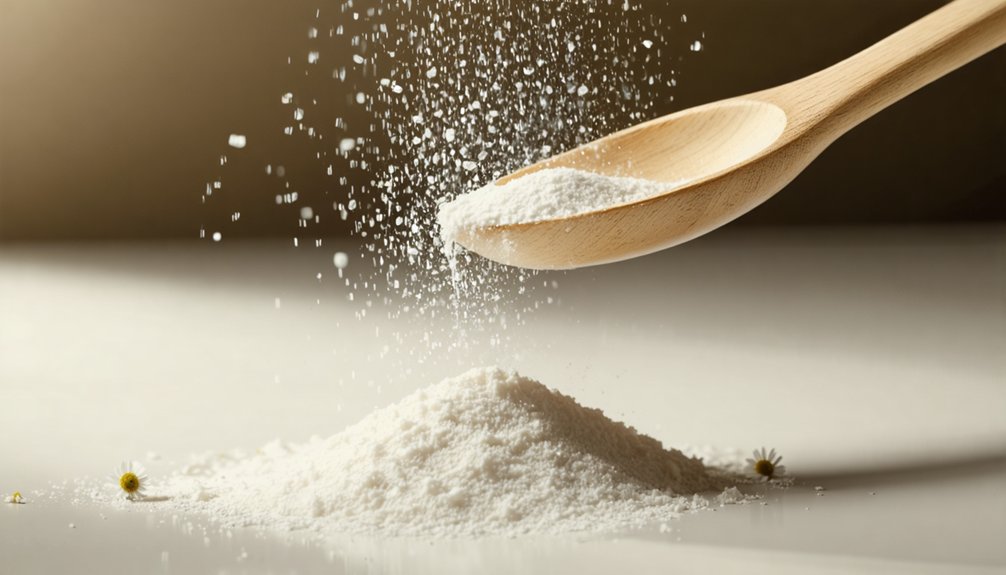When whitening sensitive teeth, you’ll want to choose a gentle powder containing protective ingredients like hydroxyapatite and strontium chloride hexahydrate. Use a soft-bristled electric toothbrush with light circular motions for 1-2 minutes, 2-3 times weekly. Look for products with biomimetic layers that mimic natural tooth structure while whitening. Monitor any discomfort and adjust frequency accordingly. Understanding the science behind gentle whitening can help you achieve ideal results while protecting your sensitive smile.
Key Takeaways
- Gentle whitening powders use carbamide peroxide for stable release of whitening agents, minimizing sensitivity while effectively removing stains.
- Contains protective ingredients like hydroxyapatite and strontium chloride hexahydrate that shield sensitive nerve endings during whitening.
- Apply with a soft-bristled electric toothbrush using gentle circular motions for 1-2 minutes, 2-3 times weekly.
- Safe for sensitive teeth when used properly, offering gradual improvements without the intense sensitivity of professional treatments.
- Features natural barrier-building components and balanced pH levels to protect enamel while achieving desired whitening results.
Understanding Teeth Sensitivity and Whitening Needs
While teeth whitening continues to grow in popularity, understanding your tooth sensitivity is essential before starting any treatment.
Before pursuing a whiter smile, take time to evaluate your tooth sensitivity to ensure safe and comfortable treatment results.
If you’re experiencing sensitivity, you’re not alone – it affects up to 50% of adults, particularly those between 18-44 years old. Women tend to report higher rates of sensitivity than men, and most people experience discomfort in multiple teeth. Cold food and drinks are among the most common triggers that can cause sensitivity discomfort. Some patients also experience pain and discomfort when using alcohol-based rinses.
When considering whitening safety, it’s vital to recognize that at-home treatments can increase sensitivity risk. The underlying cause often stems from exposed dentin through worn enamel or receding gums, which contains microscopic tubules that transmit pain signals.
These tubules respond to temperature changes, pressure, and chemical stimuli. Since about half of sensitivity sufferers don’t seek treatment, it’s important to consult a dental professional before starting any whitening regimen.
The Science Behind Gentle Whitening Powders
When exploring the science of gentle whitening powders, you’ll find their effectiveness stems from carefully controlled oxidation reactions. The process works through strategic peroxide stability and carefully balanced pH levels to guarantee safe, effective results for your patients’ smiles.
Here’s how gentle whitening powders work:
- Peroxide compounds break down stain molecules by targeting their double bonds, transforming them into lighter compounds.
- Carbamide peroxide provides a controlled, stable release of whitening agents, reducing sensitivity risks.
- A balanced pH environment maximizes peroxide activity while protecting enamel integrity.
- Non-peroxide components like mild abrasives complement the chemical whitening process for enhanced results. The active ingredients penetrate through the hardest outer layer of teeth to effectively reach underlying stains.
Understanding these mechanisms helps you select appropriate treatments for patients with varying sensitivity levels, ensuring ideal outcomes while maintaining dental health. Professional supervision ensures treatments can be enhanced with light activation technology for optimal whitening results.
Key Ingredients That Protect Sensitive Teeth
You’ll find natural barrier-building ingredients like hydroxyapatite and strontium chloride hexahydrate working together to create protective shields over sensitive nerve endings in your teeth.
These components form a biomimetic layer that mimics your tooth’s natural structure while strengthening weakened areas. This gentle approach maintains a neutral pH balance to prevent further sensitivity issues.
The formula’s enzyme-based protection system further supports these barriers by maintaining ideal oral pH and preventing the breakdown of essential minerals. The inclusion of bentonite clay helps remove toxins while supporting the remineralization process.
Natural Barrier-Building Components
Natural barrier-building components form the foundation of gentle teeth whitening powders designed for sensitive teeth.
Your natural remineralization strategies can include powerful minerals and compounds that provide effective enamel protection while maintaining tooth comfort.
Key barrier-building components include:
- Hydroxyapatite (HAp) that creates a protective layer over your teeth, physically blocking exposed dentinal tubules and rebuilding damaged enamel.
- Zinc citrate and zinc oxide that support mineral balance while providing antibacterial protection.
- Calcium carbonate that gently removes plaque while preserving your tooth’s natural barrier.
- Acacia gum that maintains ideal saliva consistency, supporting your mouth’s protective environment.
These ingredients work together to strengthen your teeth’s natural defenses while allowing for safe, comfortable whitening.
Potassium nitrate provides clinically proven sensitivity relief for those with tooth discomfort.
The addition of organic essential oils like clove and eucalyptus provides natural sensitivity relief while supporting overall oral health.
Enzyme-Based Protection Systems
Beyond barrier-building ingredients, enzyme-based protection systems offer a revolutionary approach to gentle teeth whitening.
The glucose oxidase enzyme naturally converts to hydrogen peroxide when exposed to air, providing gradual whitening effects. You’ll find powerful yet gentle proteolytic enzymes like papain and bromelain working at the molecular level to break down stubborn stains without harsh abrasives or peroxides. These naturally-derived enzymes target protein-based stains and biofilm while preserving your enamel’s structural integrity. Unlike traditional whitening methods that can cause enamel erosion, these enzymes provide safe stain removal while maintaining tooth structure.
Clinical studies confirm the enzyme efficacy of this system, showing significant stain removal without the sensitivity or irritation commonly associated with traditional whitening methods.
The non-cytotoxic nature of these enzymes, particularly bromelain, makes them ideal for daily use on sensitive teeth. When combined with low-abrasive formulations and pH-balanced ingredients, you’re getting all-encompassing protection while achieving a brighter, healthier smile.
Safe Application Methods for Best Results
To achieve ideal results with teeth whitening powder, proper application techniques and safety measures are essential. Using gentle techniques while maintaining effective results requires careful attention to the application process.
Safe and effective teeth whitening depends on proper technique and careful application to achieve optimal results while protecting your smile.
For best whitening while protecting sensitive teeth:
- Slightly dampen a soft-bristled electric toothbrush and dip it lightly into the powder, covering just the bristle tips.
- Apply using gentle circular motions for 1-2 minutes, focusing evenly on all tooth surfaces.
- Rinse thoroughly multiple times to remove all residue, then follow with fluoride toothpaste.
- Limit whitening sessions to 2-3 times weekly, and avoid cold foods immediately after treatment.
Remember to monitor any sensitivity during the process and consider using desensitizing treatments if discomfort occurs.
You’ll achieve the best results by maintaining consistent but moderate application rather than excessive use.
Common Mistakes to Avoid When Whitening

You’ll risk serious enamel damage and heightened tooth sensitivity if you leave whitening powder on longer than directed, thinking it will speed up results.
Early warning signs like tooth discomfort or gum irritation should prompt you to immediately stop treatment and adjust your approach.
Following the recommended application times and responding promptly to sensitivity will help protect your dental health while achieving ideal whitening results.
Overuse Beyond Recommended Time
While teeth whitening products can effectively brighten your smile, using them beyond the recommended time can lead to serious complications.
Proper whitening frequency and sensitivity management are essential to prevent long-term damage to your teeth and gums.
Here’s what happens when you overuse whitening products:
- Your enamel weakens and erodes, making teeth more vulnerable to decay and permanent damage.
- Tooth sensitivity intensifies, causing discomfort with hot, cold, or sweet foods.
- Gum tissue may develop chemical burns, redness, and painful ulcers.
- Teeth can whiten unevenly, creating a patchy appearance that’s difficult to correct.
To protect your dental health, always follow product instructions carefully and consider consulting a dentist for personalized guidance on safe whitening practices.
Ignoring Early Warning Signs
Many people miss the telltale signs of tooth damage during whitening treatments, leading to preventable complications and dental issues.
When you experience heightened sensitivity to hot or cold substances, gum irritation, or uneven coloration, these early signs indicate it’s time to pause your whitening regimen.
Sensitivity awareness is essential – if you’re feeling persistent discomfort, don’t push through the pain. Instead, take a break to allow your enamel and nerve endings to recover.
You’ll need to consult your dentist if symptoms persist, as continuing treatment could worsen underlying problems like cavities or cracks.
Remember, successful whitening requires responding promptly to warning signals and following professional guidance.
Using sensitivity-appropriate products and maintaining regular dental check-ups will help you achieve safer, more predictable results.
Comparing Powders to Other Whitening Options
When considering teeth whitening options, it’s essential to understand how whitening powders compare to professional treatments, strips, and tray-based systems.
While powder effectiveness tends to be gentler and more suitable for sensitive teeth, you’ll find varying results among whitening alternatives.
- Professional in-office treatments deliver the most dramatic results in a single session using high-concentration peroxide, though they’re costlier and may cause temporary sensitivity.
- Whitening strips with PAP offer peroxide-free results within 14 days, striking a balance between effectiveness and comfort.
- Tray-based systems using carbamide peroxide achieve 1-2 shade improvements over weeks but require longer application times.
- Whitening powders provide the gentlest approach through mild abrasives like baking soda or charcoal, making them ideal for sensitive teeth despite more gradual results.
Tips for Maintaining Your Brightened Smile

Maintaining your newly brightened smile requires a thorough approach that combines proper oral hygiene, dietary adjustments, and strategic whitening powder usage.
A bright smile demands commitment – from daily cleaning habits to smart food choices and careful use of whitening products.
As part of your whitening maintenance tips, brush twice daily with a soft-bristled toothbrush and floss regularly to prevent plaque buildup. Use whitening powder 2-3 times weekly alongside your regular fluoride toothpaste.
For sensitivity management techniques, avoid abrasive brushing motions and monitor for any tooth discomfort.
Protect your results by limiting staining agents like coffee, tea, and red wine, especially within 48 hours after whitening when your enamel is most vulnerable.
Choose crunchy fruits and vegetables to naturally clean teeth, and wait at least 30 minutes after whitening before consuming any colored foods or beverages.
Consider quitting tobacco use, as it greatly undermines whitening efforts.
Expert Recommendations for Long-Term Success
Professional dental experts advocate a thorough approach to gentle teeth whitening that combines proven formulations with consistent application methods.
Based on expert advice and positive customer testimonials, you’ll achieve ideal results by following these evidence-based recommendations:
- Select PAP+ or hydroxyapatite-containing powders that are clinically validated for enamel safety and sensitivity reduction.
- Incorporate the powder into your daily oral care routine, using gentle circular motions without excessive pressure.
- Monitor your teeth’s response and adjust frequency if sensitivity occurs, while maintaining regular dental check-ups.
- Stay committed to consistent use, understanding that peroxide-free solutions deliver gradual but lasting results over several weeks.
Remember that gentle whitening powders work best as part of a thorough oral care strategy, particularly for those with existing sensitivity concerns.
Frequently Asked Questions
Can I Use Whitening Powder While Wearing Braces or Dental Veneers?
You shouldn’t use whitening powder with braces or veneers. For proper braces maintenance and veneer care, consult your dentist about professional whitening options that won’t damage your dental work or cause uneven results.
How Long Should I Wait After a Dental Procedure Before Using Whitening Powder?
Like a fresh canvas needs time to dry, you’ll need to wait at least 48 hours post-procedure before using whitening powder. This reduces whitening sensitivity and guarantees proper post-procedure care.
Will Whitening Powder Affect the Color of Existing Dental Fillings?
No, whitening powder won’t change your dental restoration colors. The whitening effectiveness only works on natural tooth enamel, so your existing fillings will maintain their original shade regardless of treatment.
Can Pregnant or Nursing Mothers Safely Use Teeth Whitening Powder?
Like many expectant moms, you’ll want to postpone whitening until after pregnancy and nursing. Current safety guidelines recommend avoiding elective cosmetic treatments. Instead, try gentle brushing and non-peroxide alternatives for stain control.
Should I Brush My Teeth Before or After Using Whitening Powder?
You’ll achieve best results by brushing with regular toothpaste first, then using whitening powder 2-3 times weekly. This brushing technique guarantees proper cleaning while maintaining safe whitening frequency.
References
- https://www.trysnow.com/blogs/news/does-teeth-whitening-make-your-teeth-sensitive
- https://www.soladentalspa.com/blog/options-for-sensitive-teeth-whitening
- https://mysweetsmile.com/en-us/products/teeth-whitening-powder
- https://icybeardental.com/blogs/blog/how-to-use-teeth-whitening-powder
- https://www.gentledental.com/resources/articles/teeth-whitening-products
- https://www.drbobsdentalcare.com/is-teeth-whitening-safe-for-sensitive-teeth/
- https://mydetroitdentist.com/is-teeth-whitening-for-sensitive-teeth-a-safe-and-effective/
- https://pmc.ncbi.nlm.nih.gov/articles/PMC6784469/
- https://pmc.ncbi.nlm.nih.gov/articles/PMC3819160/
- https://pmc.ncbi.nlm.nih.gov/articles/PMC11326452/



